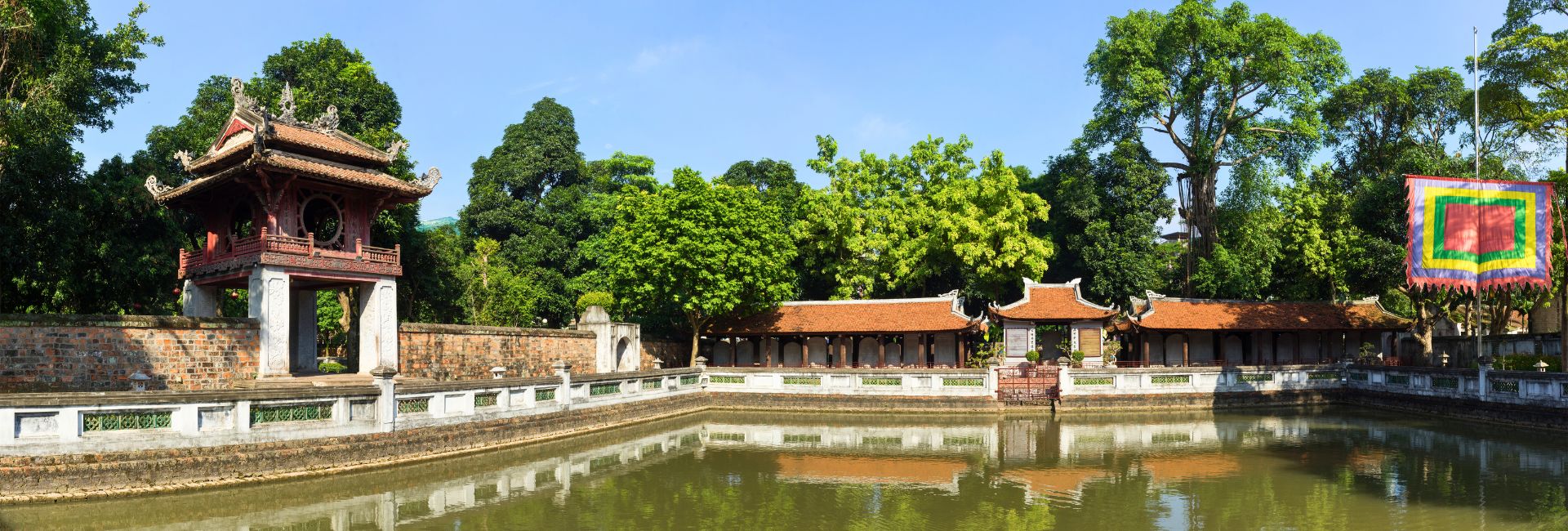The Hanoi Temple of Literature is a remarkable testament to Vietnam’s rich cultural and educational heritage. Located in the heart of Hanoi, this historic site offers visitors a unique glimpse into the country’s intellectual traditions, architectural brilliance, and deep respect for learning. As one of the most significant cultural landmarks in Vietnam, the Temple of Literature (Van Mieu – Quoc Tu Giam) promises an unforgettable experience for travelers seeking to understand the soul of Vietnamese culture.
What you will find in this travel blog:
- Get to know the Hanoi Temple of Literature
- Interesting facts about the Temple of Literature
- Historical journey of the Temple of Literature
- Architectural highlights
- Cultural Significance
- Best time to visit
- How to get there?
- Tips for visiting
- Nearby attractions
Get to know the Hanoi Temple of Literature
The Temple of Literature is more than just a historical site – it’s a living museum of Vietnamese scholarly tradition. Established in 1070, this complex has witnessed centuries of cultural and educational development.
Practical visitor information
- Location: 58 Quoc Tu Giam Street, Dong Da District, Hanoi, approximately 3 kilometers from Hoan Kiem Lake
- Opening hours: 8:00 AM – 5:00 PM daily
- Ticket prices:
- Adults: 70,000 VND ($3 USD)
- Students: 35,000 VND (student ID required)
Here is what you can expect at the Temple of Literature:
- A peaceful historical complex spanning over 54,000 square meters
- Stunning traditional Vietnamese architectural designs
- Five distinct courtyards with unique historical significance
- Ancient stone stelae documenting scholarly achievements
- Beautifully maintained gardens and historical buildings
- Insights into Vietnam’s educational and cultural history
- Opportunities for photography and cultural learning
- A serene environment that tells stories of ancient scholarship
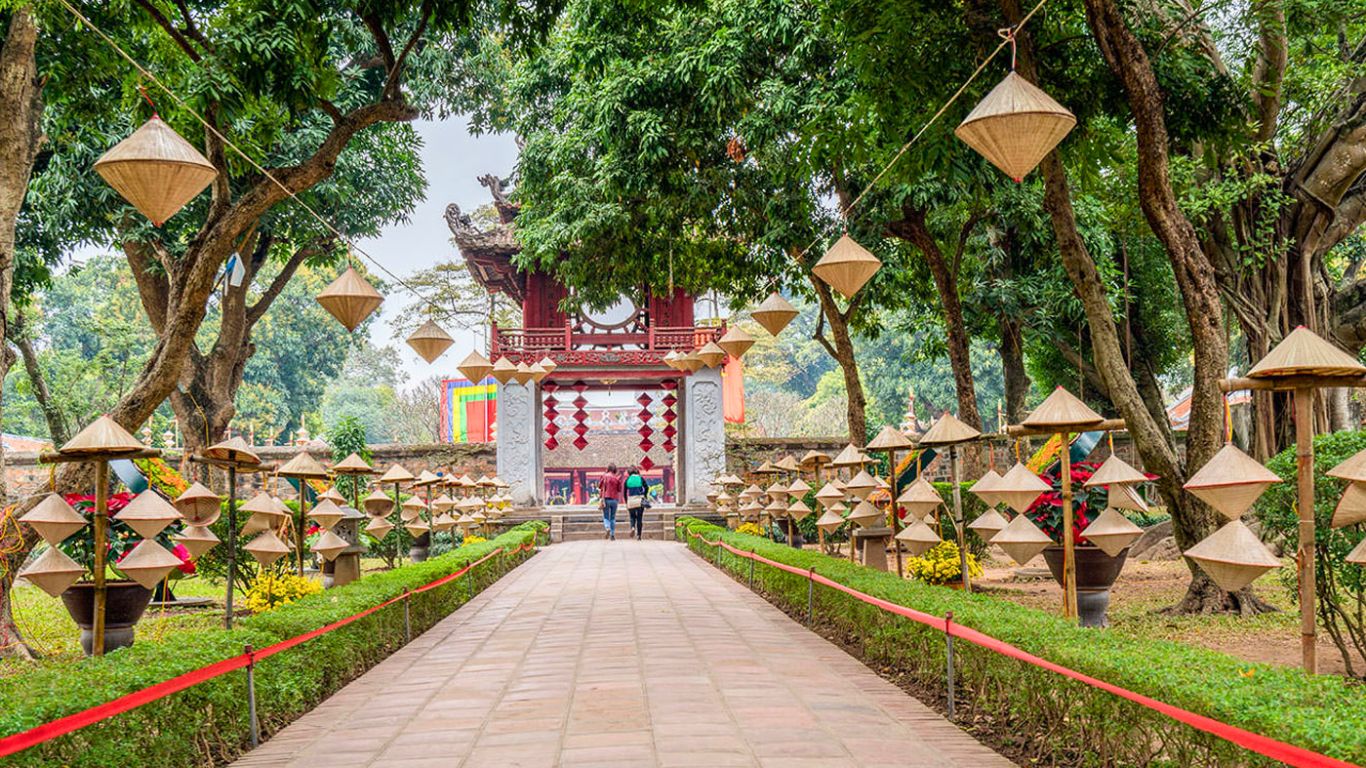
Interesting facts about the Temple of Literature
The Temple of Literature is not just a building – it’s a living piece of Vietnamese history. Here are some fascinating insights:
- It is the oldest university in Vietnam, founded in 1076 – predating Oxford University by over 200 years and Harvard by more than 400 years.
- The temple features unique “flying eaves” architecture, with curved roofs designed to prevent water damage and create an elegant aesthetic.
- Turtles play a significant symbolic role in the temple’s design, representing wisdom, longevity, and stability in Vietnamese culture.
- The complex contains 82 stone stelae mounted on turtle statues, each recording the names of successful doctoral candidates from 1442 to 1779.
- A mysterious sealed tunnel is rumored to have once connected the temple to the Imperial Citadel, though it remains inaccessible today.
Historical journey of the Temple of Literature
The temple’s history is a fascinating narrative of Vietnam’s intellectual evolution. Founded in 1070 under King Ly Thanh Tong, it was initially created to honor Confucius and serve as a royal school. In 1076, the Quoc Tu Giam (Imperial Academy) was established, becoming Vietnam’s first national university.
Initially, the school was exclusive to princes and nobles. However, in 1253, King Tran Thai Tong expanded admission to include civilians with exceptional academic abilities. The temple became a critical center of learning, producing generations of scholars who would shape Vietnam’s future.
During the Le Dynasty, the temple reached its educational peak. King Le Thanh Tong established stelae honoring doctoral graduates, creating a permanent record of academic excellence. Each stele rests on a turtle statue, symbolizing the enduring nature of knowledge.
The temple survived numerous historical challenges, including French colonial period and wars, eventually being recognized as a historical monument in 1906. Today, it stands as a preserved testament to Vietnam’s rich educational heritage.
Architectural highlights
The Temple of Literature reveals an extraordinary architectural journey through five meticulously designed courtyards. Each space tells a story, reflecting Vietnamese architectural principles and cultural symbolism.
The Front Area: Majestic Entrance
The temple’s entrance makes a powerful first impression. Four brick pillars frame the entrance, with two significant stone stelae commanding horsemen to dismount. Two lion statues sit atop the central pillars, while four phoenixes perch on the outer pillars with outstretched wings. These details weren’t just decorative – they symbolized respect and social hierarchy.
First Courtyard: Pathways of Meaning
The first courtyard connects the Great Portico (Khu Nhập Đạo) to the Great Middle Gate (Đại Trung Môn). Here, three walking paths reveal a sophisticated social system:
- Central path: Reserved exclusively for kings, royal family, and high-ranking officials
- Side paths: Used by students and common people
Two small ponds flank the garden, adding visual balance and reflection spaces. The Great Middle Gate, built in the post-Le dynasty style, features:
- Three wooden compartments
- Red shoe-shaped tiled roof
- Decorative carps and flask motifs in glazed terracotta
- Bricks from the famous Bat Trang Pottery Village
Second Courtyard: The Pavilion of Constellation
The Pavilion of Constellation (Khuê Văn Các), built in 1805, represents architectural elegance. Its unique features include:
- Four massive square brick pillars (85cm x 85cm)
- Intricate wooden structures
- Red elaborate roof
- Two circular windows
- A bronze bell used only on special occasions
This pavilion is so iconic that it appears on the 100,000 Vietnamese dong banknote and serves as a symbol of Hanoi.
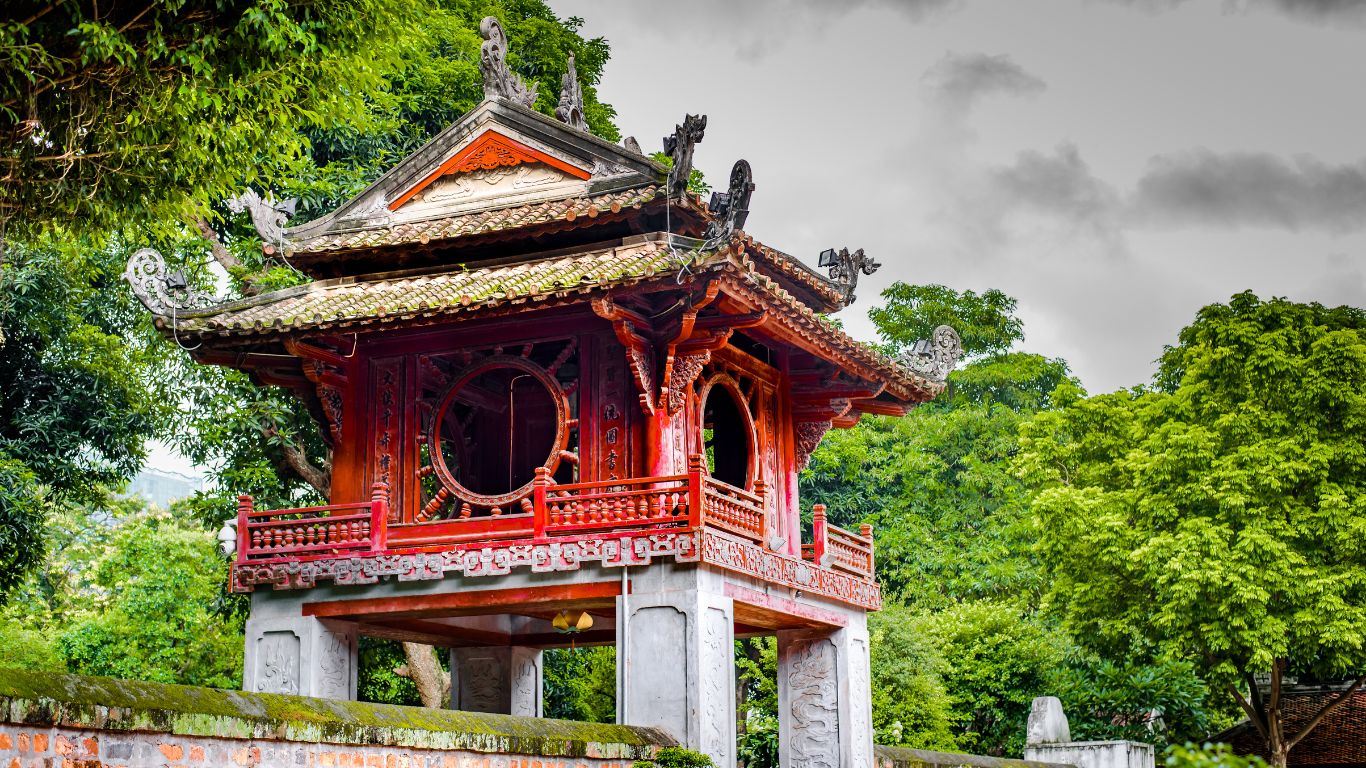
Third Courtyard: Cosmic Harmony
The Well of Heavenly Clarity (Thien Quang Well) demonstrates philosophical architectural principles:
- Square base representing earth
- Circular top representing sky
- Designed to create harmony between celestial and terrestrial realms
Surrounding the well, 82 stone stelae mounted on tortoise statues document academic achievements from 1442 to 1779. Each stele represents a successful doctoral candidate, creating a permanent record of scholarly excellence.
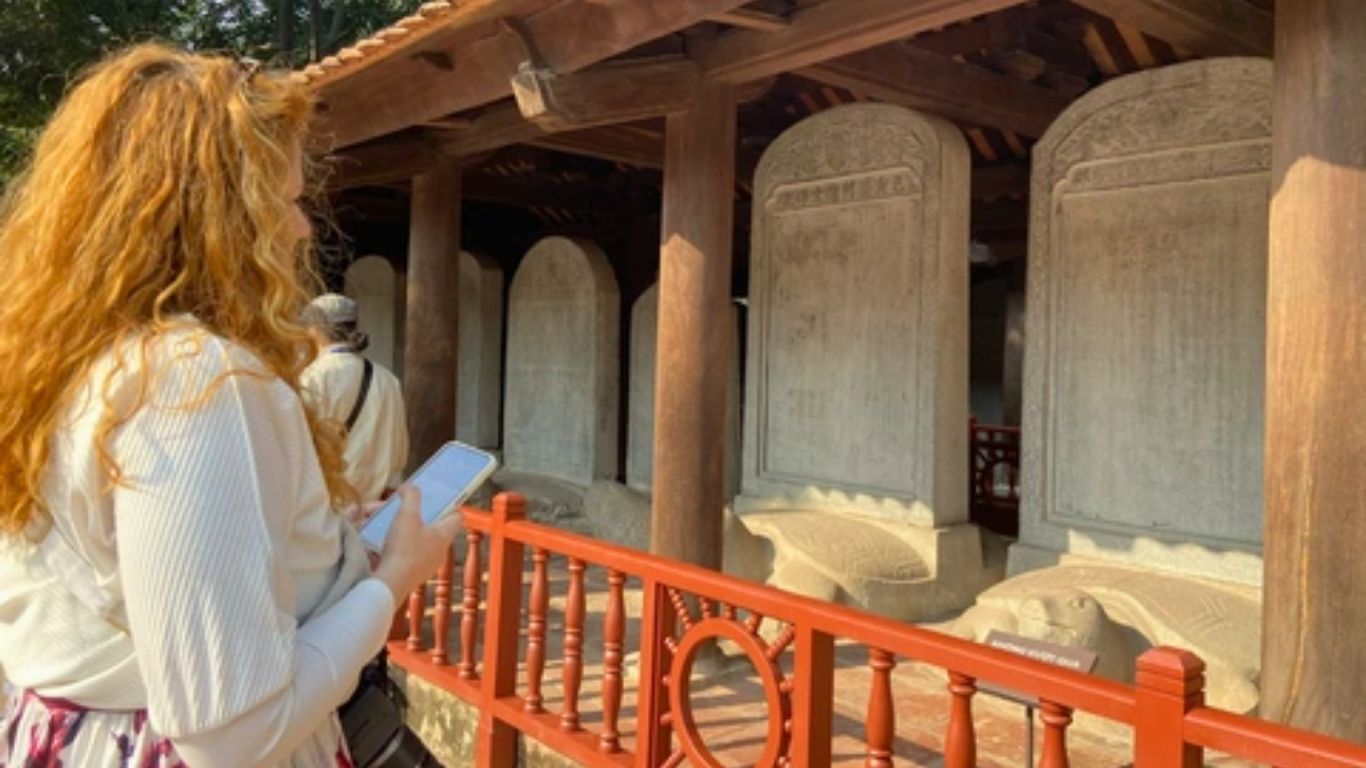
Fourth Courtyard: Spiritual Center
This central area focuses on spiritual worship, featuring:
- Parallel structures for honoring Confucius
- Spaces dedicated to Confucius’s four most brilliant students
- Areas for worshipping ten Chinese philosophers
- A primary site for Vietnamese students seeking academic blessings
Fifth Courtyard: Educational Legacy
The final courtyard houses Vietnam’s first academy, established in 1076. After destruction during the First Indochina War, it was reconstructed in 2000. Current features include:
- A statue of Chu Van An, a beloved educational leader
- Exhibits showcasing scholarly history
- Displays of traditional scholar uniforms
- Cultural event spaces
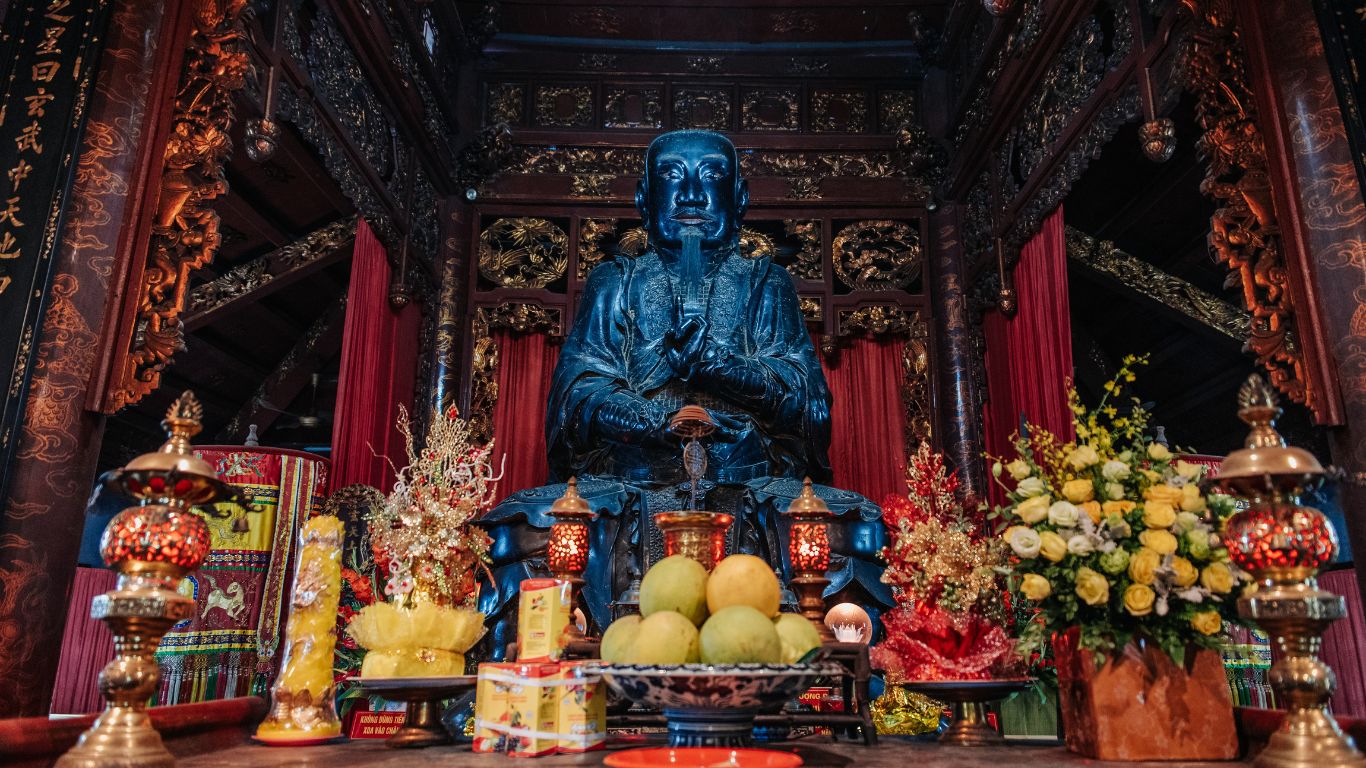
Architectural Philosophy
The entire 54,331 square meter complex follows a precise north-south axis, mirroring the temple design in Qufu, Shandong – Confucius’s birthplace. This deliberate layout reflects deep philosophical and cultural connections between Vietnamese and Chinese scholarly traditions.
The Temple of Literature’s architecture is not just about buildings. It’s a carefully constructed narrative of education, respect, and cultural values, telling stories through every brick, roof, and pathway.
Cultural Significance
More than a historical site, the Temple of Literature represents the spiritual and intellectual heart of Vietnamese culture. It embodies core values of:
- Respect for education and scholarship
- Moral and intellectual development
- National pride and cultural identity
- Preservation of traditional knowledge
- Celebration of intellectual achievement
The temple continues to be a place of inspiration, hosting cultural events, exhibitions, and serving as a bridge between Vietnam’s rich past and dynamic present.
Best time to visit
Timing your visit to the Temple of Literature can significantly enhance your experience of this historic site. Hanoi’s climate and cultural calendar offer unique opportunities throughout the year.
Seasonal considerations: The best time to visit falls between October and April when Hanoi experiences cooler, drier weather. During these months, temperatures range from 20-25°C (68-77°F), providing comfortable conditions for exploring the extensive temple grounds. The mild weather allows visitors to walk leisurely through the five courtyards without the discomfort of intense heat or heavy rainfall.
Festival periods: Vietnamese academic and cultural festivals bring the Temple of Literature to life during special times of the year. The Lunar New Year (Tet) in late January or early February transforms the site into a vibrant celebration of learning and tradition. Students and families gather to pray for academic success, creating a unique cultural experience.
Daily Timing: Early mornings offer the most peaceful experience at the Temple of Literature. The site opens at 8:00 AM, and arriving shortly after provides several advantages. The morning light creates beautiful photographic opportunities, highlighting the intricate architectural details. Fewer visitors mean you can explore the courtyards and historical exhibits without crowds.
Seasonal Highlights: Spring (February to April) presents the most picturesque views, with mild temperatures and occasional blooming flowers in the temple gardens. Autumn (October to November) offers similar pleasant conditions, with clear skies and comfortable temperatures. Summer months (May to September) can be challenging due to high humidity and frequent rainfall, though the temple remains accessible with proper preparation.
Photography and Lighting: Photographers will find the early morning and late afternoon hours ideal for capturing the temple’s beauty. The soft light highlights the ancient architecture, stone stelae, and traditional design elements. Midday sun can be harsh, creating strong shadows and making outdoor exploration less comfortable.
Pro tip for cultural enthusiasts: If possible, time your visit to coincide with Vietnam’s academic examination periods. During these times, the temple becomes a hub of cultural significance, with students and families visiting for good luck and historical inspiration.
>>> Maybe you wanna read more: Best Time to Visit Hanoi – Weather & Highlights of Season
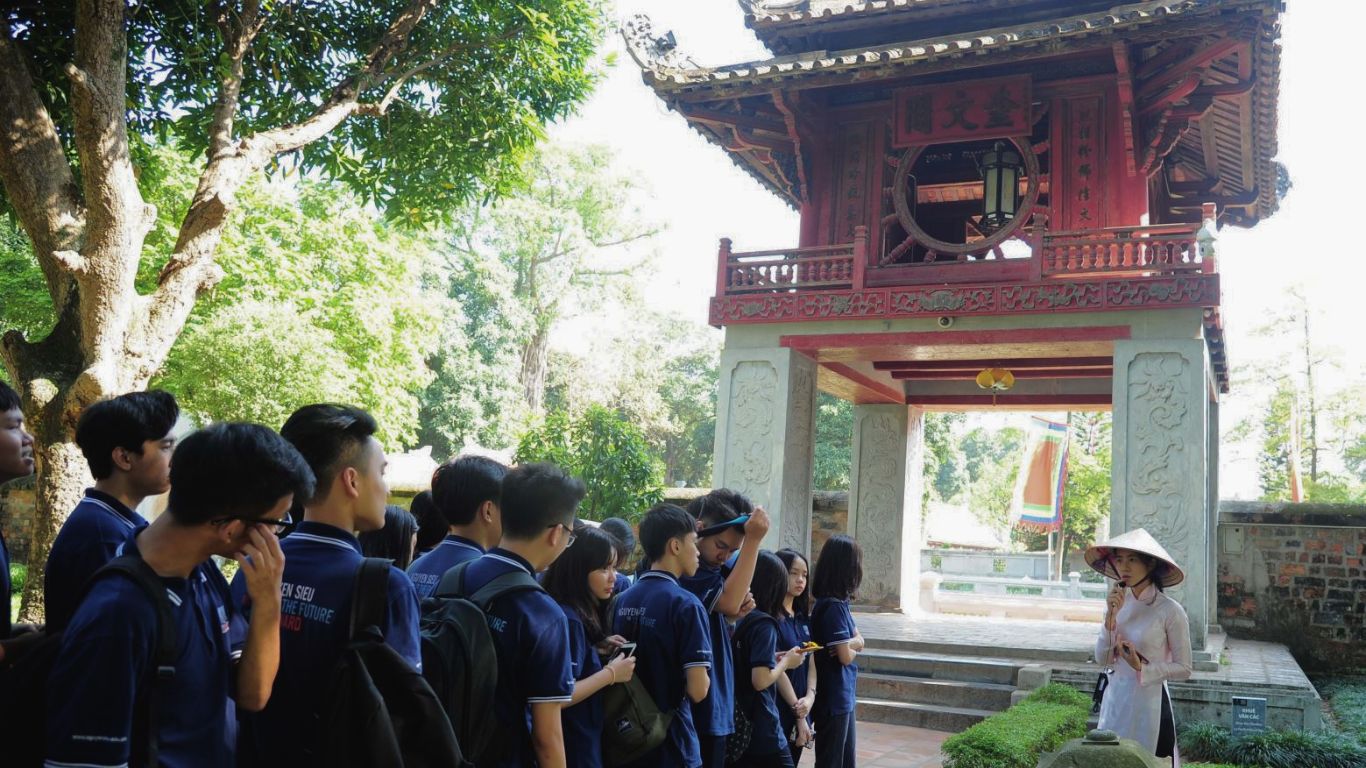
How to get there?
The Temple of Literature sits conveniently in central Hanoi, making it accessible through multiple transportation options.
Detailed transportation options:
By bus
Hanoi’s comprehensive bus network offers several routes near the Temple of Literature: Route 02, 23, 32, 38, 41
Ticket prices range from 7,000 to 15,000 VND per trip. Purchase tickets directly from the bus driver or at station counters.
By taxi
Multiple taxi services operate in Hanoi:
- Recommended Companies: Mai Linh, Vinasun, and Green Taxi
- Estimated Fare: 50,000 – 70,000 VND from city center
- Average travel time: 10-15 minutes
- Tip: Always ask the driver to use the meter
By motorbike rental
- Daily Rental Rates: 100,000 – 200,000 VND
- Parking: Available near the temple entrance
- Important Note: Wear a helmet and carry an international driving permit
Tips for visiting
- Arrive early to avoid crowds and midday heat
- Wear comfortable walking shoes
- Dress respectfully (no tank tops or short skirts)
- Bring cash for ticket purchase
- Allow 1-2 hours for a comprehensive visit
- Consider hiring a local guide for deeper historical insights
- Bring water and sun protection
- Respect the sacred nature of the site
Nearby attractions
Hanoi’s rich cultural landscape offers numerous exciting destinations near the Temple of Literature. This vibrant area is packed with historical sites, traditional markets, and modern attractions that complement your temple visit:
- Ho Chi Minh complex: A monumental historical site dedicated to Vietnam’s revolutionary leader.
- Hoa Lo Prison Museum: Explore a powerful historical site revealing Vietnam’s colonial and revolutionary history
- Vietnamese Women’s Museum: Offers fascinating insights into women’s roles in Vietnamese society
- Dong Xuan Market: A bustling traditional market showcasing Hanoi’s vibrant commercial atmosphere.
- Tran Quoc Pagoda: The oldest Buddhist temple in Hanoi, located near West Lake
- Ethnology Museum: Showcases Vietnam’s diverse ethnic cultures and traditions
- Hanoi Old Quarter: A bustling neighborhood with traditional architecture, street food, and local markets
>>> Find more about things to do in Hanoi: Hanoi in 3 days – Best things to do & Tips to beat the tourist crowd
The Hanoi Temple of Literature is more than a tourist destination – it’s a journey through Vietnam’s intellectual and cultural soul. Whether you’re a history buff, culture enthusiast, or curious traveler, this extraordinary site offers a profound connection to Vietnam’s rich heritage, Plan your visit, open your mind, and prepare to be transformed by the stories, architecture, and spirit of this remarkable place.
Mo Nguyen – From Vietnam Travel Online


